Kingsgrove Branch:
Schnap Electric Products Blog
Schnap Electric Products Blog Posts
RJ45 Socket

G'day! Sick of your Wi-Fi dropping out in the middle of a Zoom call or right at the end of the footy? Wi-Fi is handy, mate, but for a rock-solid, high-speed connection for your smart TV, gaming console, or home office PC, you just can't beat a proper hardwired connection.
And that all starts with the humble RJ45 socket. It's that little square data port on your wall plate, and it's the fair dinkum gateway to a fast, reliable internet experience.
So, What is an RJ45 Socket, Exactly?
An RJ45 socket (or 'jack', 'mech', or 'data point' as tradies call it) is the "female" port that your Ethernet cable (the one with the little clear RJ45 plug) clicks into.
Its one and only job is to be the termination point for the data cable that's running through your walls. It connects that hidden cable back to your NBN modem or a central network switch, giving you a physical, high-speed 'tap' into your home network, right where you need it.
The Ripper Benefits: Why a Hardwired Socket Beats Wi-Fi
In a country as big as ours with houses built of solid brick, Wi-Fi can be a proper nightmare. A hardwired RJ45 socket solves all those dramas.
- Blazing Fast Speeds: You'll almost always get a faster, more consistent speed than on Wi-Fi. Perfect for 4K streaming or downloading big files.
- Rock-Solid Reliability: No more random dropouts. A physical cable connection doesn't care if your neighbour fires up their microwave or if you've got thick brick walls.
- Lower Latency (Ping): This is the big one for gamers. A wired connection gives you a much lower, more stable ping for a lag-free experience. You can't blame the connection when you miss that shot!
The Big Confusion: RJ45 vs. That Old Phone Socket (RJ11)
This is the bit that catches people out. An RJ45 socket looks like the bigger, beefier brother of the old telephone socket.
- RJ45 (The Internet Socket): This is the wide one, with 8 internal pins. It's for data and networking (Cat6).
- RJ11 (The Old Phone Socket): This is the skinny little fella, with usually 4 or 6 pins. It's only for old-school landline telephones.
They look similar, but they're not interchangeable. You can't plug your NBN cable into an old phone jack.
The CRITICAL Safety & Compliance Warning: This is NOT a DIY Job, Mate!
Righto, let's get dead serious for a sec, because this is the most important part of the whole article.
Buying a pre-made Ethernet cable (a 'patch lead') to run outside your walls from the RJ45 socket to your computer? That's a "go for your life" DIY job. Too easy.
But what if you want a new data point in your study? This involves running a new data cable inside your walls, floor, or ceiling and terminating it at a new RJ45 socket.
In Australia, this is strictly not a DIY job. Any fixed data, communications, or telephone cabling must be installed by a licensed cabler (registered with ACMA).
Why? It's the law, mate. A dodgy data install (especially with cheap parts from a non-specialist supplier) can create interference (messing up your and your neighbour's NBN). Worse, if it's run too close to 240V power wiring without proper separation, it can become a serious electrical hazard. Don't be a galah.
A Professional Job Needs Professional Gear
A licensed cabler or licensed electrician knows that a rock-solid, high-speed network relies on high-quality, compliant components from end to end. They can't risk a job on a cheap, dodgy RJ45 socket that will fail in a year.
This is why they source their gear from a trusted electrical wholesaler. As one of Australia's most comprehensive electrical wholesaler and supplier networks, Schnap Electric Products stocks the lot for the professional installer. They've got a massive range of high-quality, professional-grade data gear, including RJ45 socket mechanisms ('mechs'), wall plates, Cat6 data cable, patch panels, and all the specialist crimping and testing tools that a qualified professional needs to do the job right, compliant, and ready for high-speed Aussie internet. For a connection that won't let you down, the pros start with quality gear from a supplier like Schnap Electric.
RJ45 Coupler
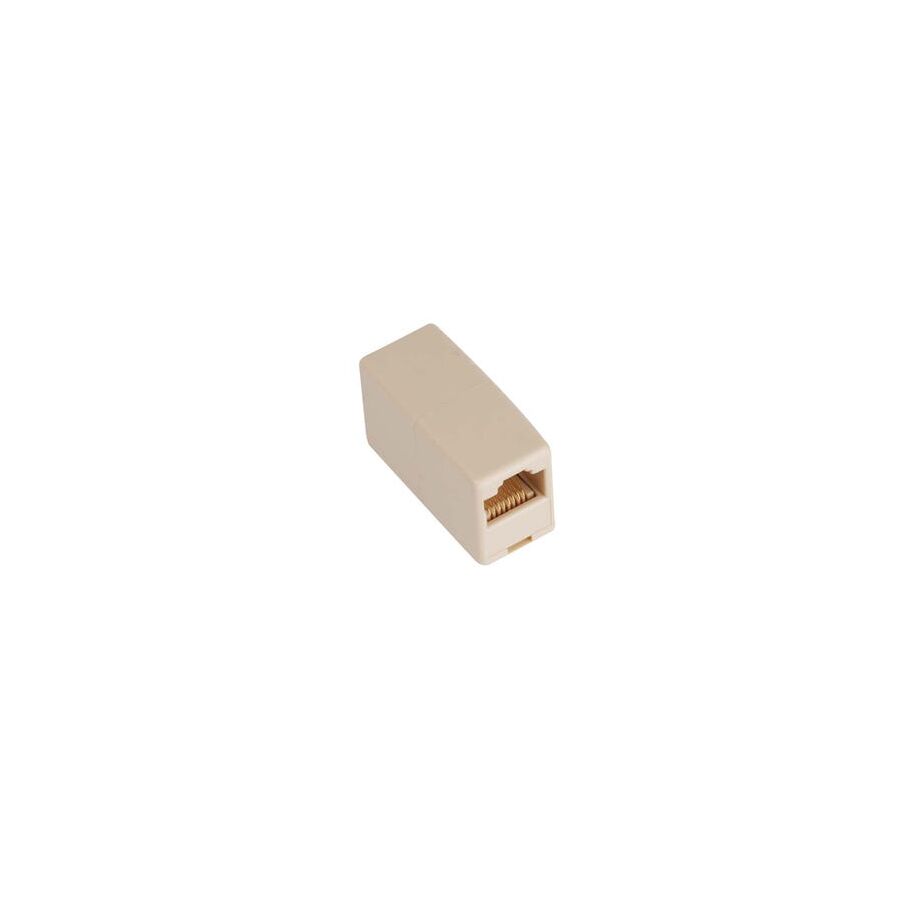
G'day! You're setting up the new home office. You've positioned the desk perfectly for the light, you've got your computer sorted, and then you go to plug in the internet cable and... bugger. It won't bloody reach. It's about a metre too short.
It's a fair dinkum frustrating moment. You could go out and buy a whole new 10-metre cable, or you could muck around moving all your furniture. But before you do that, there's a simple, cheap-as-chips little gadget that can save your bacon: the RJ45 coupler.
So, What is an RJ45 Coupler, Exactly?
An RJ45 coupler (also known as an 'Ethernet joiner' or an 'inline coupler') is a simple little plastic box. On the inside, it's basically just two RJ45 sockets (the female ports) wired straight through, back-to-back.
Its one and only job is to let you plug one Ethernet patch cable (with an RJ45 plug) into one side, and another patch cable into the other side. Click, click. Job done. You've just joined them together to make one longer cable. Too easy!
The Ripper Benefits (When to Use One)
This little bit of kit is a proper lifesaver for a few common situations:
- The Quick Extension: This is the big one. Your NBN modem is on one side of the room, and your computer is just that little bit too far away. A coupler and a second cable sorts it out in seconds.
- A Temporary Fix: Perfect for when you're moving a desk or a smart TV just for the weekend and don't want to run a whole new cable.
- Joining Two Spare Cables: You've got two short 3-metre patch leads, but you need a 5-metre run. A coupler gets the job done without you having to drive to the shops.
The Big Catch: A Join is Still a Join, Mate
Righto, here's the catch, and it's an important one. While an RJ45 coupler is a fantastic quick fix, a professional cabler will tell you that any extra connection in a line is a potential point of failure.
A coupler introduces two new connection points (a plug and a socket on each side). This can (in some cases) slightly slow down your signal or introduce a weak point where a connection can get a bit dodgy if it's knocked.
For the absolute best, most rock-solid, high-speed connection, a single, unbroken cable from the wall plate to your computer is always the go-to. But for 99% of home jobs, a good quality coupler will work a treat.
The CRITICAL Safety & Compliance Warning: DIY vs. Pro
This is where we get dead serious, mate.
- DIY (Go for your life!): Using an RJ45 coupler to join two loose patch cables (the ones outside your wall) is 100% fine. It's a simple, low-voltage DIY job.
- PRO ONLY (Stop, mate!): Are you thinking of using a coupler to join two cables inside your wall cavity to save running a new line? DO NOT DO THIS. It's dodgy, it's unprofessional, and it's against the Aussie cabling rules. It will create a hidden point of failure that will be a nightmare to find later.
Any fixed data cabling inside your walls must be installed by a licensed cabler (registered with ACMA). A pro will never join a cable in a wall; they will always run a new, solid cable from the patch panel to the wall socket.
A Professional Job Needs Professional Gear
A licensed cabler or licensed electrician knows that a reliable network depends on high-quality, compliant components from end to end. They can't risk a job on a cheap, dodgy coupler that will just fail in a year. This is why they source their gear from a trusted electrical wholesaler.
As one of Australia's most comprehensive electrical wholesaler and supplier networks, Schnap Electric Products stocks the lot for the professional installer. They've got a massive range of high-quality, professional-grade data gear, including reliable RJ45 couplers (Cat6 and Cat6a), wall mechanisms ('mechs'), data cable, and all the specialist tools a qualified professional needs to do the job right. For a connection that won't let you down, the pros start with quality gear from a supplier like Schnap Electric.
RJ45 Ethernet Cable
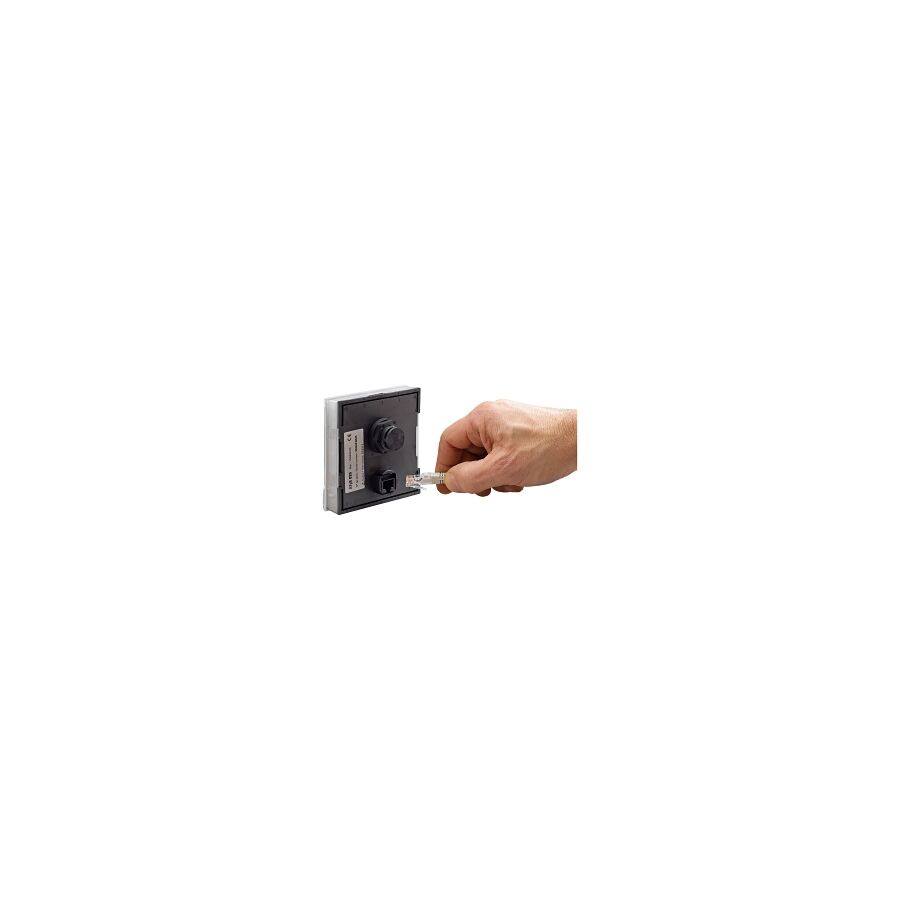
G'day! You're in the middle of a grand final stream, it hits the last two minutes, and... buffering. Or you're on a vital Zoom call, and your face freezes. It's a fair dinkum nightmare, and it's almost always that bloody Wi-Fi playing up.
For a rock-solid, reliable connection, you just can't beat a hardwired solution. That's where the RJ45 Ethernet cable comes in. It's the unsung hero of a fast, lag-free Aussie internet connection.
What is an RJ45 Ethernet Cable, Exactly?
This is where the lingo gets a bit mixed up, so let's clear it up.
- The Cable: This is the long bit, usually a 'Category 6' (Cat6) or 'Category 5e' (Cat5e) cable, which has 8 individual wires inside (in 4 twisted pairs).
- The RJ45: This is the plug (or connector) on the end. It's that little clear plastic clip with 8 tiny pins that clicks into your modem.
But let's be honest, everyone in Australia just calls the whole thing an RJ45 Ethernet cable, and we all know what we mean. Its one and only job is to carry high-speed digital data from your modem or router straight into your device.
Don't confuse it with your grandad's phone cable! A proper RJ45 Ethernet cable has that wide 8-pin plug. The old-school telephone plug (an RJ11) is much skinnier and only has 4 or 6 pins. They're not interchangeable.
Why Bother? Isn't Wi-Fi Good Enough?
Wi-Fi is ripper for wandering around the house with your phone or laptop. No doubt about it. But for your high-demand, stationary gear (like your smart TV, gaming console, or home office PC), Wi-Fi can be a proper nightmare. It can be flaky, slow, and get interference from your neighbour's network or even the bloody microwave!
A hardwired RJ45 Ethernet cable gives you a direct, stable, physical connection. This means:
- Faster Speeds: You'll almost always get a faster, more consistent speed than on Wi-Fi.
- Lower Latency (Ping): This is the big one for gamers. A wired connection gives you a much lower ping for a lag-free experience.
- Rock-Solid Reliability: No more random dropouts in the middle of a 4K movie or a massive Zoom call. You beauty!
The Quick Guide: Cat5e vs. Cat6
When you buy an RJ45 Ethernet cable, you'll see "Cat5e" or "Cat6" on the packet.
- Cat5e: This is the older standard. It's fine for most basic Aussie NBN plans.
- Cat6: This is the new, modern standard. It's a bit thicker, has better internal shielding (to stop interference), and can handle much faster speeds (up to 10 Gigabits over shorter runs). For any new install, you'd be a galah not to use Cat6. It's what any pro would recommend.
The CRITICAL Safety & Compliance Warning: DIY vs. Pro
Righto, this is the most important part, so listen up.
- DIY: Buying a pre-made RJ45 Ethernet cable (called a "patch lead") from a shop to run outside your walls from the socket to your PC? Go for your life, mate. Too easy.
- PRO ONLY: Want a new data point in your study or media room? This involves running a data cable inside your walls, floor, or ceiling and terminating it at a wall plate.
In Australia, this is strictly not a DIY job. Any fixed data, communications, or telephone cabling must be installed by a licensed cabler (registered with ACMA).
Why? It's the law, mate. A dodgy data install (especially with cheap parts from a non-specialist supplier) can create interference (messing up your and your neighbour's NBN). Worse, if it's run too close to 240V power wiring without proper separation, it can become a serious electrical hazard. Don't be a galah.
A Professional Job Needs Professional Gear
A licensed cabler or licensed electrician knows that a rock-solid, high-speed network relies on high-quality, compliant components from end to end. They can't risk a job on a cheap, dodgy cable that will fail in a year. That's why they source their gear from a trusted electrical wholesaler.
As one of Australia's most comprehensive electrical wholesaler and supplier networks, Schnap Electric Products stocks the lot for the professional installer. They've got a massive range of high-quality, professional-grade Cat6 RJ45 Ethernet cable, connectors ('jacks' and 'plugs'), wall plates, and all the specialist crimping and testing tools that a qualified professional needs to do the job right, compliant, and ready for high-speed Aussie internet. For a connection that won't let you down, the pros start with quality gear from a supplier like Schnap Electric.
RJ45 Jack
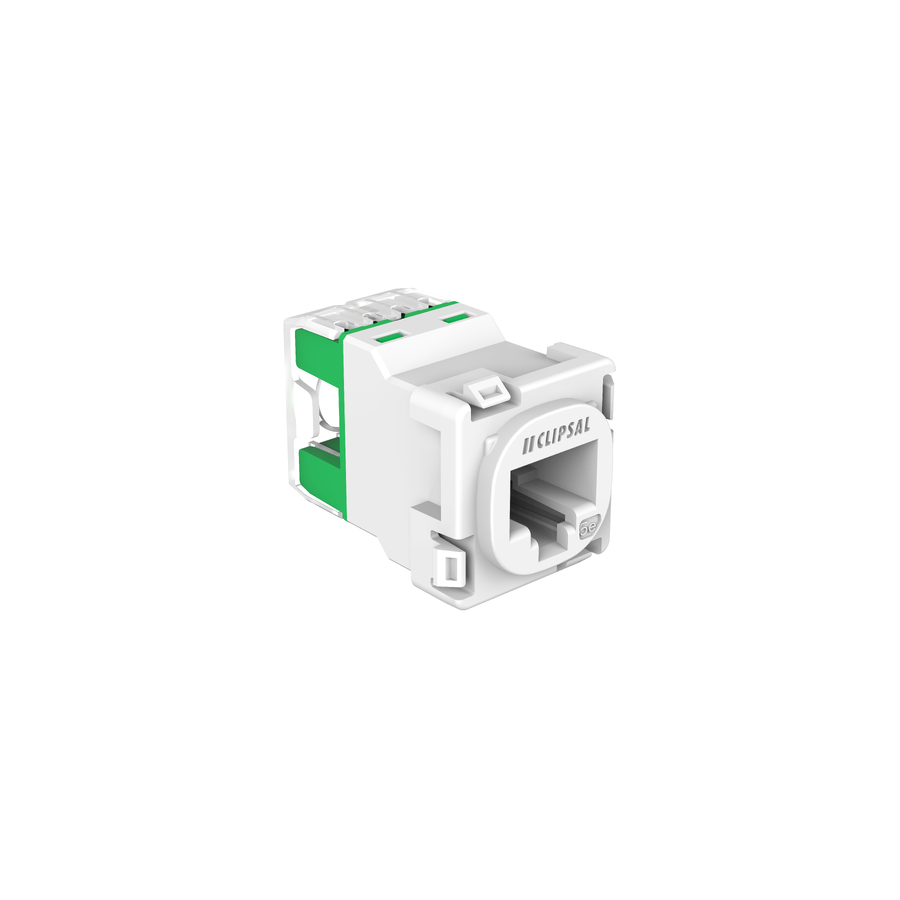
G'day! Sick of your Wi-Fi dropping out in the middle of a Zoom call or right at the end of the footy? Wi-Fi is handy, mate, but for a rock-solid, high-speed connection for your smart TV, gaming console, or home office PC, you just can't beat a proper hardwired connection.
And that all starts with the humble RJ45 jack. It's that little square data port on your wall plate, and it's the fair dinkum gateway to a fast, reliable internet experience.
So, What is an RJ45 Jack, Exactly?
An RJ45 jack (or 'Ethernet socket', 'data point', or 'mech' as tradies call it) is the "female" port that your Ethernet cable (the one with the little clear RJ45 plug) clicks into.
Its one and only job is to be the termination point for the data cable that's running through your walls. It connects that hidden cable back to your NBN modem or a central network switch, giving you a physical, high-speed 'tap' into your home network, right where you need it.
The Ripper Benefits: Why a Hardwired Jack Beats Wi-Fi
In a country as big as ours with houses built of solid brick, Wi-Fi can be a proper nightmare. A hardwired RJ45 jack solves all those dramas.
- Blazing Fast Speeds: You'll almost always get a faster, more consistent speed than on Wi-Fi. Perfect for 4K streaming or downloading big files.
- Rock-Solid Reliability: No more random dropouts. A physical cable connection doesn't care if your neighbour fires up their microwave or if you've got thick brick walls.
- Lower Latency (Ping): This is the big one for gamers. A wired connection gives you a much lower, more stable ping for a lag-free experience. You can't blame the connection when you miss that shot!
The Big Confusion: RJ45 vs. That Old Phone Socket (RJ11)
This is the bit that catches people out. An RJ45 jack looks like the bigger, beefier brother of the old telephone socket.
- RJ45 (The Internet Socket): This is the wide one, with 8 internal pins. It's for data and networking (Cat6).
- RJ11 (The Old Phone Socket): This is the skinny little fella, with usually 4 or 6 pins. It's only for old-school landline telephones.
They look similar, but they're not interchangeable. You can't plug your NBN cable into an old phone jack.
The CRITICAL Safety & Compliance Warning: This is NOT a DIY Job, Mate!
Righto, let's get dead serious for a sec, because this is the most important part of the whole article.
Buying a pre-made Ethernet cable (a 'patch lead') to run outside your walls from the RJ45 jack to your computer? That's a "go for your life" DIY job. Too easy.
But what if you want a new data point in your study? This involves running a new data cable inside your walls, floor, or ceiling and terminating it at a new RJ45 jack.
In Australia, this is strictly not a DIY job. Any fixed data, communications, or telephone cabling must be installed by a licensed cabler (registered with ACMA).
Why? It's the law, mate. A dodgy data install (especially with cheap parts from a non-specialist supplier) can create interference (messing up your and your neighbour's NBN). Worse, if it's run too close to 240V power wiring without proper separation, it can become a serious electrical hazard. Don't be a galah.
A Professional Job Needs Professional Gear
A licensed cabler or licensed electrician knows that a rock-solid, high-speed network relies on high-quality, compliant components from end to end. They can't risk a job on a cheap, dodgy RJ45 jack that will fail in a year.
This is why they source their gear from a trusted electrical wholesaler. As one of Australia's most comprehensive electrical wholesaler and supplier networks, Schnap Electric Products stocks the lot for the professional installer. They've got a massive range of high-quality, professional-grade data gear, including RJ45 jack mechanisms ('mechs'), wall plates, Cat6 data cable, patch panels, and all the specialist crimping and testing tools that a qualified professional needs to do the job right, compliant, and ready for high-speed Aussie internet. For a connection that won't let you down, the pros start with quality gear from a supplier like Schnap Electric.
RJ45 Splitter
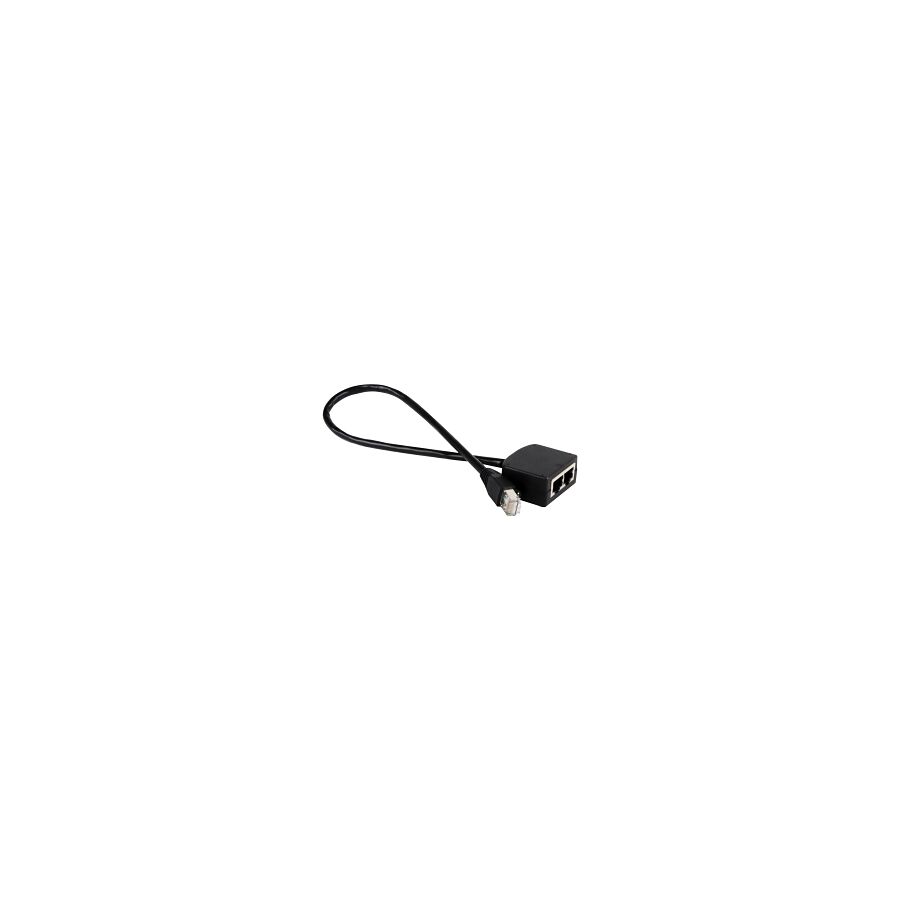
G'day! You're in the home office, you've finally got the desk set up, but you're facing a classic Aussie reno problem. You've got one data point (RJ45 socket) in the wall, but you need to plug in two devices – say, your computer and your printer.
It's a bloody pain. So, you hop online or head down to the shops and find a cheap, $5 gadget called an RJ45 splitter. It's a little 'Y' shaped adapter. Too easy, right? You just plug it in and turn one socket into two.
Hold your horses, mate. Before you waste your money, you need to know that for 99% of modern internet setups, this little gadget is a fair dinkum trap.
The Big Con: Why That Cheap Splitter is a Dud
Here's the lowdown. A simple, passive RJ45 splitter (the 'Y' adapter) does not let two devices share one internet connection at the same time.
It's a con, basically. These splitters were designed for a very old, specific purpose. Old-school 10/100 Ethernet (the slow stuff) only used 4 of the 8 wires inside the cable. These splitters work by sending one set of 4 wires to one port and the other set of 4 to the second port. You'd need another splitter on the other end to join them back up. It was a proper mess.
Here's the problem: Your modern Aussie NBN and any decent network runs on Gigabit Ethernet, which needs all 8 wires to work.
If you plug a standard RJ45 splitter into your wall, you'll be lucky if one of your devices works (at a knackered, slow speed). Most likely, nothing will work at all. It's a dog's breakfast of a solution.
What You Actually Need: The Network Switch
Righto, so the splitter is a dud. What you're actually looking for isn't a splitter; it's a Network Switch.
Think of a network switch as a smart, high-tech power board, but for your internet. It's a small box that you plug into the power, and it does the job properly:
- You run one Ethernet cable from your RJ45 socket on the wall into the "in" port on the switch.
- Boom! The switch then gives you 4, 8, 16, or more live Ethernet ports.
- You can then plug your computer, your printer, your smart TV, and your gaming console all into the switch, and every single one gets a full-speed, rock-solid, hardwired connection.
It's the real solution, and it's the only one a professional would ever use.
The CRITICAL Safety & Compliance Warning: DIY vs. Pro
This is where we get dead serious, mate.
- DIY: Buying a pre-made Ethernet cable (a 'patch lead') and a simple, desktop network switch from a retailer? Go for your life, mate. Too easy. That's a safe, low-voltage job.
- PRO ONLY: Want to install a new data point in your study? This involves running a data cable inside your walls, floor, or ceiling and terminating it at a wall plate.
In Australia, this is strictly not a DIY job. Any fixed data, communications, or telephone cabling must be installed by a licensed cabler (registered with ACMA).
Why? It's the law, mate. A dodgy data install (especially with cheap parts from a non-specialist supplier) can create interference (messing up your and your neighbour's NBN). Worse, if it's run too close to 240V power wiring without proper separation, it can become a serious electrical hazard. Don't be a galah.
A Professional Job Needs Professional Gear
A licensed cabler or licensed electrician knows that a rock-solid, high-speed network relies on high-quality, compliant components from end to end. They wouldn't be caught dead using a cheap RJ45 splitter on a pro job. They get their gear from a trusted electrical wholesaler.
As one of Australia's most comprehensive electrical wholesaler and supplier networks, Schnap Electric Products stocks the lot for the professional installer. They've got a massive range of high-quality, professional-grade data gear, including high-performance network switches, Cat6 data cable, wall jacks, and all the specialist crimping and testing tools that a qualified professional needs to do the job right. For a connection that won't let you down, the pros start with quality gear from a supplier like Schnap Electric.
RJ45 Wall Plate
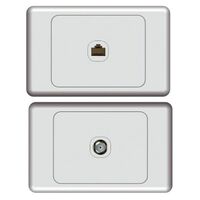
G'day! Let's talk about that battle we all have. You're trying to stream the footy in 4K, or you're on a massive Zoom call for work, and the bloody Wi-Fi starts dropping out. It's buffering, it's lagging, and it's a fair dinkum nightmare.
Wi-Fi is ripper for wandering around with your phone, but for your serious gear—your smart TV, your gaming console, or your home office PC—you just can't beat a rock-solid, hardwired connection. And that, mate, all starts with a proper RJ45 wall plate.
So, What is an RJ45 Wall Plate, Exactly?
An RJ45 wall plate is the 'socket' side of your internet connection. It's the female port on the wall that you plug your Ethernet (RJ45) cable into.
In Aussie tradie lingo, the actual socket part is called a 'mech' (mechanism) or a 'jack'. This little RJ45 jack then clips into a standard Aussie wall plate, often right next to your power points (GPOs).
Its one and only job is to be the neat, tidy, and professional termination point for the data cable that's running through your walls, connecting your room directly back to your NBN modem or network switch.
The Ripper Benefits: Why a Hardwired Point Beats Wi-Fi
In a country full of double-brick homes that are proper Wi-Fi killers, a hardwired RJ45 wall plate is a game-changer.
- Blazing Fast Speeds: You'll almost always get a faster, more consistent speed than on Wi-Fi. Perfect for 4K streaming or downloading big files.
- Rock-Solid Reliability: No more random dropouts. A physical cable connection doesn't care if your neighbour fires up their microwave or if you've got thick brick walls.
- Lower Latency (Ping): This is the big one for gamers. A wired connection gives you a much lower, more stable ping for a lag-free experience. You can't blame the connection when you miss that shot!
- It Just Looks Schmick: It's the proper, professional finish. No more daggy cables stapled around the skirting boards.
The CRITICAL Safety & Compliance Warning: This is NOT a DIY Job, Mate!
Righto, let's get dead serious for a sec, because this is the most important part of the whole article.
- DIY: Buying a pre-made Ethernet cable (a 'patch lead') to run outside your walls from the RJ45 wall plate to your computer? Go for your life, mate. Too easy.
- PRO ONLY: Want to install a new data point? This involves running a new data cable inside your walls, floor, or ceiling and terminating it at a new RJ45 wall plate.
In Australia, this is strictly not a DIY job. Any fixed data, communications, or telephone cabling must be installed by a licensed cabler (registered with ACMA).
Why? It's the law, mate. A dodgy data install (especially with cheap parts from a non-specialist supplier) can create interference (messing up your and your neighbour's NBN). Worse, if it's run too close to 240V power wiring without proper separation, it can become a serious electrical hazard. Don't be a galah.
A Professional Job Needs Professional Gear
A licensed cabler or licensed electrician knows that a rock-solid, high-speed network relies on high-quality, compliant components from end to end. They can't risk a job on a cheap, dodgy RJ45 wall plate that will fail in a year or, worse, isn't even rated for Cat6 speeds.
This is why they source their gear from a trusted electrical wholesaler. As one of Australia's most comprehensive electrical wholesaler and supplier networks, Schnap Electric Products stocks the lot for the professional installer. They've got a massive range of high-quality, professional-grade data gear, including RJ45 wall plate mechanisms ('mechs'), stylish faceplates (like the Clipsal Iconic range), Cat6 data cable, and all the specialist crimping and testing tools that a qualified professional needs to do the job right. For a connection that won't let you down, the pros start with quality gear from a supplier like Schnap Electric.
RJ45 Pass Through Connector

G'day! If you've ever tried to make your own Ethernet cable (a patch lead), you know the absolute frustration. You're there, squinting at those eight tiny, bloody wires, trying to get them in the right T-568B order (White-Orange, Orange, White-Green...). You spend ages getting them flat and straight. You trim them perfectly to length, shove them into that little clear RJ45 plug, and... bugger.
You've got two wires that have crossed over, or one's not pushed in far enough. It's a proper dog's breakfast, and you've just wasted a plug. It's a fiddly, annoying job that's the bane of many a DIYer and even some pros.
But there's a fair dinkum brilliant solution that makes this job 100 times easier. It's the RJ45 pass through connector.
So, What is a Pass Through Connector, Exactly?
A RJ45 pass through connector (sometimes called an "EZ-RJ45") looks almost identical to a standard RJ45 plug. But it has one magic difference: the little tunnels for the wires are open at the end.
Instead of having to trim your 8 wires to the perfect length and jam them into a closed-off plug, you just:
- Strip the cable.
- Get your 8 wires in the right order.
- Shove them all the way through the plug, so they poke right out the front end.
This is a total game-changer, mate.
The Ripper Benefits: Why It's a Schmick Idea
So why is this simple change so bloody good?
- You Can't Muck Up the Order: This is the big one. Because the coloured wires are sticking right out the front, you can visually check that they are in the 100% correct order before you crimp it. No more guesswork.
- Way Less Fiddling: You don't have to be a surgeon trying to trim all 8 wires to the exact same length. Just get them in order and push them through. It saves a heap of time and frustration.
- A Better, More Reliable Connection: Because you can pull the wires all the way through, you can make sure the outer jacket of the cable is properly seated inside the plug for a good, strong strain relief. It also allows the twist in the wire pairs to be maintained closer to the pins, which is better for signal quality and reducing interference.
The One BIG Catch: You Need the Right Tool!
Righto, listen up, because this is the non-negotiable part. You cannot use your old, standard RJ45 crimping tool. It won't work.
You must use a specific RJ45 pass through crimping tool.
This tool is a clever bit of kit. It has the standard crimper to push the pins in, but it also has a built-in blade at the front. As you squeeze the handle, it does two jobs in one: it crimps the pins and it neatly slices off all the excess wires that are poking out the front, all in one go. It's a beautiful thing.
The CRITICAL Safety & Compliance Warning: DIY vs. Pro
This is where we get dead serious, mate.
- DIY: Are you making a "patch lead" (a loose cable to run from your wall socket to your computer or from your modem to your router)? Go for your life. This is a top-notch DIY job, and a RJ45 pass through connector will make it dead easy.
- PRO ONLY: Are you wanting to install a new data point? This means running a data cable inside your walls, floor, or ceiling and terminating it at a wall plate.
In Australia, this is strictly not a DIY job. Any fixed data, communications, or telephone cabling must be installed by a licensed cabler (registered with ACMA).
Why? It's the law. A dodgy data install (especially with cheap parts from a non-specialist supplier) can create interference (messing up your and your neighbour's NBN). Worse, if it's run too close to 240V power wiring without proper separation, it can become a serious electrical hazard.
A Professional Job Needs Professional Gear
A licensed cabler or licensed electrician knows that a rock-solid, high-speed network relies on high-quality, compliant components from end to end. They get their gear from a trusted electrical wholesaler to ensure it's all trade-quality.
As one of Australia's most comprehensive electrical wholesaler and supplier networks, Schnap Electric Products stocks the lot for the professional installer. They've got a massive range of high-quality, professional-grade data gear, including RJ45 pass through connectors (Cat6 and Cat6a), the matching pass-through crimping tools, high-speed data cable, and all the wall jacks and plates that a qualified professional needs to do the job right. For a connection that's fast and reliable, the pros start with quality gear from a supplier like Schnap Electric.
What is RJ45

G'day! You've seen them everywhere. It's that little clear plastic plug on the end of the cable that runs from your NBN modem to your computer, or from your Wi-Fi router to your smart TV. It's the plug that makes that satisfying click when you push it in.
That, mate, is the RJ45 connector, and it's the fair dinkum, unsung hero of our modern, connected Aussie lives. But what is RJ45, why is it the standard, and when should you absolutely not mess with it?
So, What is RJ45, Exactly?
RJ45 (which stands for Registered Jack 45) is the technical name for the standard connector used in computer networking. We're talking Ethernet cables, mate.
Its one and only job is to be the plug on the end of a data cable, allowing you to plug your devices into the network. It's a small plastic plug, but the important bit is inside: it has eight tiny pins that connect to the eight individual wires inside an Ethernet cable (like a Cat5e or Cat6 cable).
This 8-pin setup is what allows it to handle the massive, high-speed data streams we need for fast NBN, 4K streaming, and online gaming.
The Big Confusion: RJ45 vs. That Old Phone Plug (RJ11)
This is the bit that catches people out. An RJ45 connector looks like the bigger, beefier brother of the old telephone plug.
- RJ45 (The Internet Plug): This is the wide one, with 8 pins. It's for data and networking.
- RJ11 (The Old Phone Plug): This is the skinny little fella, with usually 4 or 6 pins. It's only for old-school landline telephones.
They look similar, but they're not interchangeable, mate. Trying to jam your NBN plug into an old phone socket is a recipe for a bad time.
Why is it the Go-To Connector? (The Ripper Benefits)
The RJ45 is the king of networking for a few simple reasons:
- It's Standardised: Every NBN box, modem, router, computer, and smart TV in the world has the same port. It just works.
- It's Reliable: That little plastic 'clicky' tab (the one that always snaps off when you stand on it!) is a positive locking mechanism. It holds the plug securely in the socket, so a dodgy connection won't drop you out in the middle of a Zoom call.
- It's Fast: The 8-pin design is what allows it to handle the blazing-fast speeds of modern Ethernet, up to 10 Gigabits per second with the right cable.
The CRITICAL Safety & Compliance Warning: DIY vs. Pro
Righto, let's get dead serious for a sec, because this is the most important part of the whole article.
- DIY: Buying a pre-made Ethernet cable (a 'patch lead') with RJ45 plugs on the end from a shop is a "go for your life" DIY job. Too easy.
- PRO ONLY: Wanting to install a new data point in your study or home theatre? This involves running a data cable inside your walls and connecting it to a socket (an RJ45 "mech").
In Australia, this is strictly not a DIY job. Any fixed data, communications, or telephone cabling must be installed by a licensed cabler (registered with ACMA).
Why? It's the law, mate. A dodgy data install (especially with cheap parts from a non-specialist supplier) can create interference (messing up your and your neighbour's NBN). Worse, if it's run too close to 240V power wiring without proper separation, it can become a serious electrical hazard. Don't be a galah.
A Professional Job Needs Professional Gear
A licensed cabler or licensed electrician knows that a rock-solid, high-speed network relies on high-quality, compliant components from end to end. They can't risk a job on a cheap, dodgy RJ45 plug that will fail in a year.
This is why they source their gear from a trusted electrical wholesaler. As one of Australia's most comprehensive electrical wholesaler and supplier networks, Schnap Electric Products stocks the lot for the professional installer. They've got a massive range of high-quality, professional-grade data gear, including RJ45 plugs, wall sockets ('mechs'), Cat6 data cable, patch panels, and all the specialist crimping and testing tools that a qualified professional needs to do the job right, compliant, and ready for high-speed Aussie internet. For a connection that won't let you down, the pros start with quality gear from a supplier like Schnap Electric.
What Does a Blown Fuse Look Like
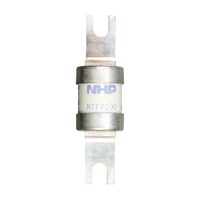
G'day! We've all been there. You're in the ute, and the radio suddenly dies. Or you're at home, you fire up the air fryer and the kettle at the same time, and pop – the power to the kitchen goes dead.
There's a fair dinkum good chance you've blown a fuse. A fuse is a simple, cheap little safety device. It's a sacrificial lamb – a deliberate weak link designed to blow (or "melt") to protect your expensive gear or your home's wiring from a dangerous power surge or overload.
But when you pull it out, what does a blown fuse look like? Well, mate, it depends on what type of fuse you're dealing with. Let's have a squiz.
The Car Fuse (The Coloured 'Blade' Fuse)
This is the most common one you'll be checking yourself. It's that little coloured plastic plug with two metal prongs.
- What a Good Fuse Looks Like: Look through the clear plastic top. You'll see a small, intact, 'S'-shaped metal link that connects the two prongs. It's all one clean, unbroken piece.
- What a Blown Fuse Looks Like: This is usually dead obvious. The metal link inside will be broken or visibly separated. You'll see a gap where the link used to be. In a really bad overload, you might also see a black, sooty, or burnt-looking smudge on the inside of the plastic where the link has vaporised. If it's broken, she's knackered.
The Appliance Fuse (The Little Glass Tube)
You'll find these little glass tubes (cartridge fuses) in a lot of appliance plugs (like on your old computer or power board) or inside the guts of electronic gear.
- What a Good Fuse Looks Like: Hold it up to the light. You'll see a tiny, thin filament wire running right through the middle, from one metal end cap to the other. It looks perfect and unbroken.
- What a Blown Fuse Looks Like: The thin wire inside is broken or completely missing. Sometimes, if it was a massive fault, the inside of the glass tube will be black and sooty, or look cloudy or milky. This is a dead giveaway that it's cactus.
The Old-School House Fuse (The Ceramic Plug)
Righto, serious safety warning first, mate. If your home has an old ceramic fuse box (not a modern switchboard with flicky switches), you are dealing with 240V mains power. This is not a DIY-friendly area.
What does a blown fuse look like in this case? This is a job for a licensed electrician, but here's what they'll look for:
- They will turn the main power switch for the whole house OFF first.
- They will carefully pull out the white ceramic fuse holder for the circuit that's dead.
- Inside, they'll see the thin fuse wire stretched between two screws.
- If it's blown, that fuse wire will be broken, melted, or completely gone. Often, there will be a black, sooty mark on the ceramic where the wire has vaporised.
If your ceramic fuses keep blowing, it's a massive sign that your wiring is overloaded and you need a switchboard upgrade. Don't be a galah and stick a nail or a bigger wire in there – that's just asking for a house fire.
The "Can't Fail" Method: The Multimeter Test
Sometimes, especially on small electronics fuses, the break in the wire is so tiny you just can't see it. This is when you use a multimeter. It's the only way to be 100% sure.
- Make sure the fuse is OUT of the device and all power is off.
- Set your multimeter to the Continuity (the "beep") setting or the lowest Ohms (Ω) setting.
- Touch one probe to one end of the fuse and the other probe to the other end.
- If it BEEPS (or reads near 0 Ohms): The fuse is GOOD.
- If it stays SILENT (or reads "O.L." / "1"): The fuse is BLOWN.
A Blown Fuse is a Warning Sign
Remember, a fuse doesn't just blow for fun. It's a symptom of a problem (like a faulty appliance or an overloaded circuit). If you're dealing with old ceramic fuses at home, it's a sign you need a professional.
A licensed electrician will replace that entire daggy old fuse box with a modern, safe switchboard. They'll use high-quality, compliant components like circuit breakers and life-saving safety switches, sourced from a trusted electrical wholesaler. As one of Australia's most comprehensive electrical wholesaler and supplier networks, Schnap Electric Products stocks the lot. They provide the modern, safe circuit breakers and RCBOs to replace those old fuses, ensuring a qualified professional has the gear to do the job right and keep your home safe for donkey's years.
Fuse
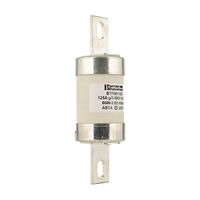
G'day! You've seen 'em everywhere – in the plug for your power board, in a little box under the dash of your ute, and if you live in an older Aussie home, you've probably got a whole row of 'em in a ceramic box on the wall. We're talking about the humble fuse.
It might seem like a simple, old-school bit of kit, but it's a fair dinkum lifesaver. It’s been the silent guardian in electrical circuits for donkey's years. So, what is a fuse, and what's it actually doing?
What is a Fuse, Exactly?
A fuse is a simple, sacrificial safety device. That's its whole job. It's a deliberate "weak link" in an electrical circuit. Its one and only purpose is to protect the wiring and the appliance from getting too much current (power), which can cause a proper disaster, like a fire.
It's not there to protect you from a shock (that's a safety switch, mate!), but it's a critical fire prevention tool.
How Does It Actually Work? The 'Sacrifice'
It's dead simple, really. Inside every fuse – whether it's a glass tube, a plastic blade, or a bit of wire in a ceramic holder – is a small, thin strip or filament of metal. This wire is precisely rated for a certain amount of current (measured in Amps).
- Normal Operation: Power flows through the fuse wire to the circuit, easy as. No dramas.
- Overload or Fault: You plug in the heater, the kettle, and the air fryer all at once. This 'overload' draws a massive, unsafe amount of current through the circuit, way more than the house wiring is built for.
- The Sacrifice: Before that massive surge can melt the wiring in your walls or fry your appliance, the little, thin fuse wire heats up in a fraction of a second and melts.
- The Result: The wire breaks, the circuit is broken, and the power is instantly cut. The fuse has "blown." It's sacrificed itself to save the day.
The Big Difference: Fuse vs. Circuit Breaker (The Modern Solution)
This is the main thing to know, mate.
- A Fuse is a one-shot wonder. Once it's blown, it's knackered. You have to physically replace it (either the whole fuse or the fuse wire).
- A Circuit Breaker (the switch in a modern switchboard) does the exact same job of stopping overloads, but it's reusable. When it trips, you just go to the board and flick the switch back on (after unplugging the dodgy appliance, of course!). It's heaps safer, more convenient, and more reliable.
The CRITICAL Safety Warning: 240V vs. 12V
Righto, let's get dead serious for a sec.
- 12V Fuses (Cars/Boats): If you're replacing a 12V blade fuse in your ute or tinnie, go for your life. That's a safe DIY job. Just make sure you replace it with one of the exact same amp rating.
- 240V Fuses (Your Home): If you're dealing with the 240V ceramic fuses in your home, you're playing with fire. It is illegal and extremely dangerous for anyone other than a licensed electrician to do fixed wiring or mess with a switchboard.
If your old ceramic fuses keep blowing, it's a massive warning sign that your system is overloaded. Don't be a galah and stick a nail or a bigger bit of wire in there to "fix it" – that's just asking for a house fire. It's time to call a pro for a switchboard upgrade. They will source all the right, compliant breakers from a proper electrical wholesaler and get your home safe.
A Professional Job Needs Professional Gear
A modern, safe home is built on modern protection. A licensed electrician knows that a safe installation depends on high-quality, compliant components. As one of Australia's most comprehensive electrical wholesaler and supplier networks, Schnap Electric Products stocks the lot for the professional installer. While they stock all kinds of specialised fuses for specific industrial applications, their main game is providing the modern, high-quality circuit breakers, RCBOs, and safety switches that replace those old, daggy fuse boxes. This ensures your home is protected by the best, most reliable gear on the market, all sourced from a trusted electrical wholesaler that the pros rely on.









